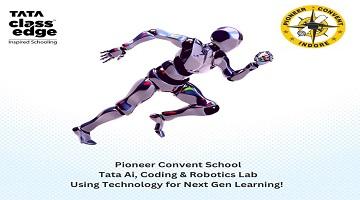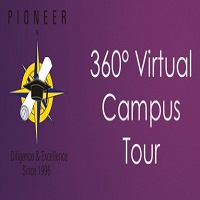Powered by Tata Class Edge
Our Vision
We at Pioneer Group always thrive to give our students the best of learning experience. We always look forward towards new technologies and advanced learning methods so that our teachers & students get the best teaching learning experience.
Why learn AI, Coding & Robotics?
In today’s era, all the modern industries are using Artificial Intelligence (AI). Most of the industries whether they are automobile industry or otherwise are using Robots in their manufacturing assembly lines. If we talk about the latest technologies, all devices and even modern homes lights, ACs, etc. can now be controlled by Speech Recognition technologies such as Alexa, Siri, Google Voice commands. There is so much innovation in automobile industry and state of the art cars like Tesla that these vehicles use AI technology to automate driving experience. Machines used in day to day life for marking attendance are using Face Recognition technology to mark attendance. Police and Administration are using advanced face recognition technology to control crimes and recognize the persons in mass volume. Hand written text is automatically recognized and converted to digital text.
The Question arises – What is the technology and science behind these devices? How these devices learn on their own? How these technology is being developed and refined?
The Answer is – Artificial Intelligence (AI), Coding and Robotics. Sandbox for Innovation – The Implementation of National Education Policy 2020 and CBSE skill subjects along with Coding, Artificial Intelligence and Robotics
Think Edge Lab“I hear and I forget. I see and I remember. I do and I understand.” Tata Class Edge Think Edge Labs aims at enabling schools towards creating an ecosystem to foster learning, creativity, and innovation in Coding, Artificial Intelligence, Machine Learning and Robotics which is aligned with CBSE Skill Subjects and NEP 2020. It helps students from classes 3-12 to understand complex industry-standard AI and robotics concepts in an easy and playful manner through exciting real world application-based DIY projects.
What is offered in the learning & curriculum?
Coding – Graphical & Python
Artificial Intelligence
Robotics
Self-Driving Technology
Tinkering
Automation
Curriculum is totally aligned with CBSE and NEP 2020. Our lab provides an year long curriculum for classes 3-12 divided in 3 stages:-
Class 3 to 5
Class 6 to 8
Class 9 to 12
What is special about this advanced AI, Coding & Robotics Lab?
PictoBlox – Coding & AI Software Buddy – Programmable Using Scratch & Python
PictoBlox is a state-of-the-art software platform that brings hardware interfacing and AI-learning to your fingertips. Available across all platforms, from smartphones to laptops, it provides an enriching and fulfilling project-based learning experience through its built-in AI & ML tools. With its Scratch-like user-friendly interface, kids can dive and explore the world of AI, robotics, and programming with ease. PictoBlox also packs a Python IDE, that allows kids a smooth transition from graphical programming to syntax programming while building their very own DIY robots. Tata Class Edge has developed Quarky – The Brain of AI Lab. Quarky is a super fun learning companion that makes learning new technologies like artificial intelligence and robotics engaging and fun.
Summary
In nutshell and to summarize, the AI, Coding & Robotics Lab will empower students from Class 3 to 12 to learn and develop the science behind new emerging and ever evolving technologies. Students these days see in every day life how new technologies are being used and are very curious to know the science behind them. Our AI, Coding and Robotics Lab is empowered by Tata Class Edge which is the best lab available for learning.
Wishing you all the best for futuristic learning!
Team Pioneer








